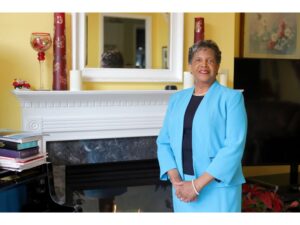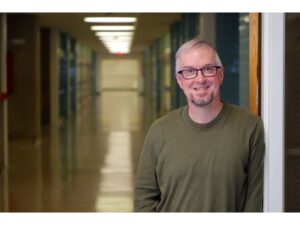
by Linda L. Esterson, photography by Nikola Tzenov
While health care workers and first responders have notably demonstrated immeasurable levels of heroism over the past year, another group deserves recognition as the county’s unsung heroes: teachers.
When the pandemic closed schools in March of last year, much like employees of a variety of businesses, teachers needed to not only pivot but reinvent themselves. They went from teaching in front of a class of students using textbooks, whiteboards, and paper and pencils, to teaching fully virtual before converting to a hybrid environment where they had to teach both in person and virtually simultaneously. Throughout the pandemic experience, teachers have used Google Classroom, a learning management system, to post lessons and resources online and Google Meet, a virtual meeting application, to hold classes. Many had never used these technologies prior to COVID.

“Teachers are heroes right now. They have accomplished more in the last year than they would over several years in a regular school environment,” says Cindy McCabe, chief of schools for Carroll County Public Schools. “It’s required them to do some intensive learning, and it’s required many hours of preparation for them to be able to meet the needs of students.”
Teachers acknowledge they’ve spent more time planning and grading than ever before. That’s in addition to the time needed to learn the new technologies.
“A lot of them are putting in extraordinary hours beyond the official school day, checking in with their kids, and making phone calls and having follow up lessons if needed, for certain students,” says Pat Dorsey, a former teacher and member of the CCPS Board of Education. “They are putting in a great deal of time trying to make it work and trying to have the kids be successful.”
Jess Morelock, a special-education teacher providing individualized learning at Mechanicsville Elementary School, said she works until 9 p.m. most nights preparing materials, organizing for the following day, learning the Google suite technology and pulling resources from internet sites. That has been the case since the beginning of the pandemic, when she found herself overwhelmed and stressed, and there was no line between school and home. She’d wake up at 3 a.m. and take care of what was on her mind.
“From March to June, I cried more frequently than I ever have before,” she says. “It was just so stressful.”
Her school’s administration provided guidance, and Morelock coordinated individual lessons for her students, spending additional time to make sure the information was free from educational jargon and understandable to parents, who continue to pitch in to help.
“My job is to educate kids and to communicate with their families in order to provide their child an education,” she says. “That’s what I do.
“When it comes down to it, my kids make it all worthwhile. And it doesn’t matter if we’re virtual, hybrid, in-person, teaching from halfway around the country — I don’t care. My kids are my kids. At the end of the day, I see them learn and that’s why I do what I do.”
Danielle Whitworth, a seventh-grade STEM teacher at Mt. Airy Middle School, estimates she spends about 80 hours a week planning for virtual, hybrid and in-person instruction. She’s communicated more than ever with parents regarding the challenges of remote learning, missed assignments or missed attendance during virtual days. It could be the result of a lacking internet connection or a faulty webcam, or even students not electing to turn on their cameras and microphones. As a result, teachers like Whitworth have needed to be more patient and understanding. Noting these issues, the county has developed new expectations for grading, allowing students to turn work in late, McCabe says.

“We don’t know what each of these kids is going through on a daily basis, if they’ve had relatives who are sick, if they’ve had parents who’ve lost their job, or any number of things,” said Andrew Isacco, South Carroll High School AP government and U.S. history teacher. “I’ve really just given them way more of the benefit of the doubt now, because I don’t want to be the guy who makes it worse for them.”
Isacco estimates he has spent about 30 percent more time planning, grading, organizing and creating multiple versions of assignments and tests in addition to learning the technology. “It reminded me of my first year of teaching — just having to relearn everything,” he says.
Aside from technology, one of the greatest challenges has been keeping students engaged when they are not physically in the classroom.
“It’s a lot more difficult when they’re at home, with the distractions the home environment can provide,” McCabe acknowledges. “Teachers have had to utilize ways to keep students motivated and interested in the learning at hand. That has required them to be creative, and to be great at connecting the learning to real world situations.”
Whitworth dug deep to alter her lessons using virtual labs and videos. Often, she coordinated remote labs that would enable the students to conduct the experiments themselves. For a recent catapult launch, she provided a supply list, and either the parents purchased the items on their own or she assembled kits for pickup at school. She also dropped off packages in mailboxes on her way home from school. During virtual teaching, her students enjoyed making and launching their own catapults, recording videos and logging data. She’s also offered an optional coding competition.
Isacco, in his 21st year of teaching, was forced to change his educational style. He customarily develops relationships with his students and presents material in an animated way, engaging the students. But in a virtual environment, he used multiple screens to be able to see the students who were remote while presenting resources at the same time. There was less walking around the room to stress a point and more class discussion. With the changing dynamics and state of the country, his priority instead was to make sure the students felt supported and they knew he was there to listen.
“Sometimes we wouldn’t necessarily talk about what was in the curriculum; we might talk about what was going on in the world,” he says. “I think the kids just wanted to know that you’re interested in them, and that you that you care about them, and that you’re willing to listen.”
After completing a day’s lesson, all of which were reworked to be visual, Isacco left his Google meet open, so students could return for help with assignments, to vent or just to talk.
“When you build those relationships, they trust you and they will allow you in and they’ll allow themselves to learn from you,” he explains. “The teachers aren’t the only ones who had to adjust. The students had to adjust, too. I don’t think many people talk about that. We’re adults and we have years of experience under our belt, and these kids are young adults and are just forming. They don’t have all this experience and to be thrown into this and be asked to do all these different things and adapt. We had to give them time and space to figure it out, too.”

The enormous amount of time spent by teachers has not gone unnoticed. “I think everyone understands the extra hours and the extra workload that this presents for teachers,” says McCabe. “And I think everyone is grateful for the dedication of our teachers that they’re willing to put that time into what they do. … People go into teaching to help students, so they’re going to put in the time that’s needed to make sure that their students are learning what they need to learn. And, for many, if not all, it’s become an all-encompassing job.”
Many teachers have the added responsibility of juggling the need to assist their own children with remote learning or care for an ill family member. Some found it too difficult to manage and opted to take personal leave. Some have already returned, some plan to return in the fall, and some have retired. During the peak of remote instruction, Whitworth hired a mother’s helper to assist her three elementary-age children with their schooling.
Instead of focusing on the anxiety and the challenges, Jena Ehmann chose to focus on learning.
“After all, education — our job — is learning,” says Ehmann, ELA specialist at Winfield Elementary School and Carroll County’s 2020 Teacher of the Year. “We, as teachers, want students to learn each day. This year, we are learning alongside them. We tell students learning can be difficult. Learning takes practice. Learning happens over time. Teachers are experiencing these lessons, too.”
As teachers and students have learned about themselves and acquired new skills using the new technology and applications, schooling going forward will continue to evolve. McCabe anticipates teachers will continue to utilize learning management systems. Carroll County is piloting the use of Schoology, another learning management system, in some classes this spring.
“When I was 7, I knew I wanted to be a teacher. As this year unfolds, I have no doubts that I still want to teach!” Ehmann says. “After all, the fundamental structure of education has not changed. The delivery has merely been adjusted. Consistent communication, clear expectations, and a focus on authentic learning continues to take place in our schools, whether learning and teaching virtually or in person, whether during a pandemic or not.”
McCabe notes all that teachers are doing for their students, from the long hours to the extra planning to learning themselves to keep them engaged and learning.
“A pandemic comes usually once in a lifetime,” McCabe said. “They have stepped up to the plate and been true heroes for us. And none of us will be able to express enough gratitude for that.”

The Teacher as a Parent
With the move to remote then hybrid instruction, students throughout the county have acquired new skills. They have learned to type. Their computer navigational skills have strengthened. They’ve mastered the use of webcams and video software.
Teacher Danielle Whitworth has seen her sons thrive. She attributes much of their success to the teachers at Robert Moton Elementary School. But when she revels in their success, she’s not only referring to academics.
“They have turned into these little empathetic people,” she says. “They do chores without me asking now. They see when I’m working, and they tell each other to be quiet. I hate when they do that. But then I also love when they do that.”
The “magical” positive spin the teachers are instituting for the Whitworth children, and all others, shows them that the world does not revolve around them, that they need to help other people. And that provides a positive sense of self-esteem.
“My kids’ teachers are heroes,” says Whitworth.













